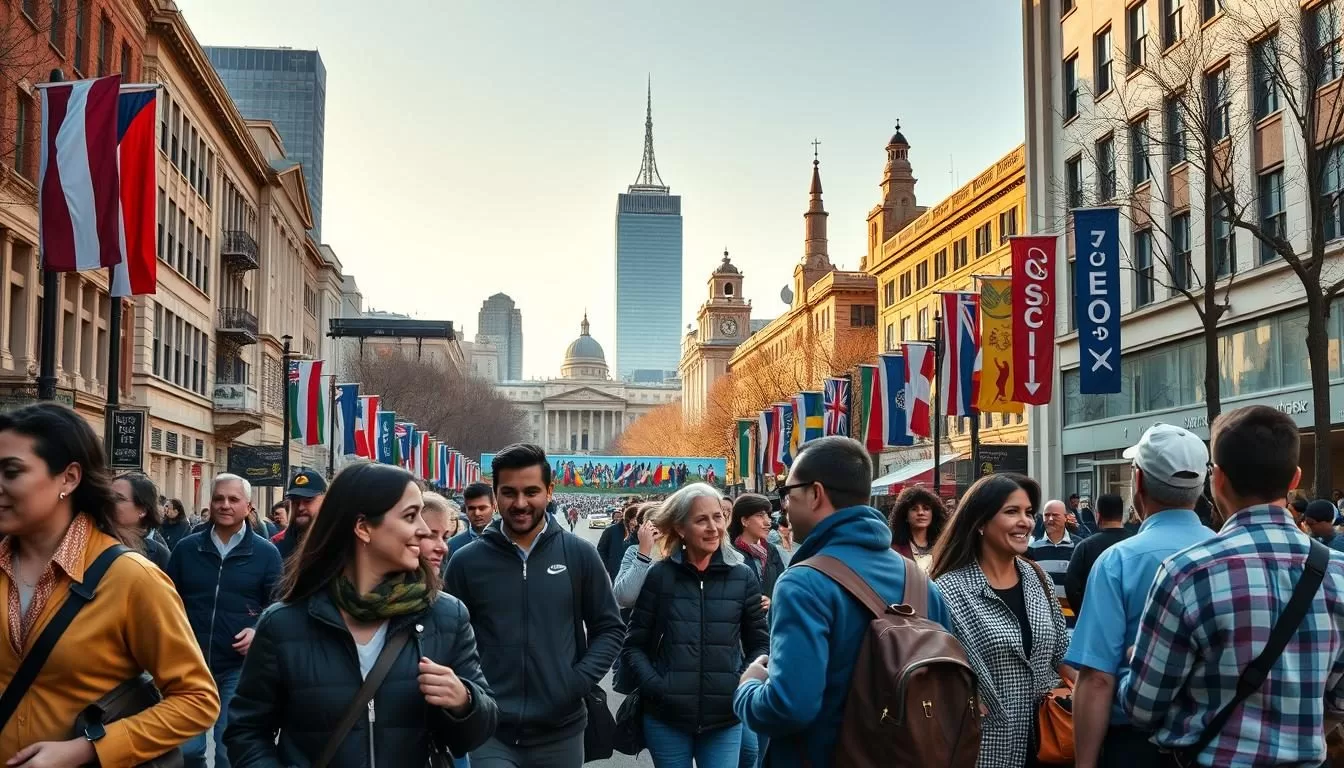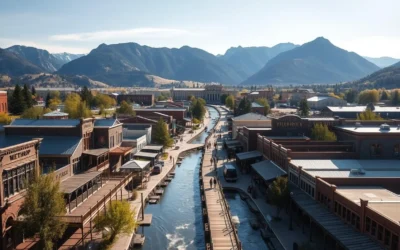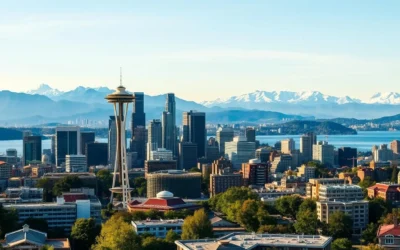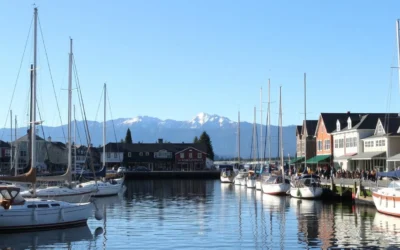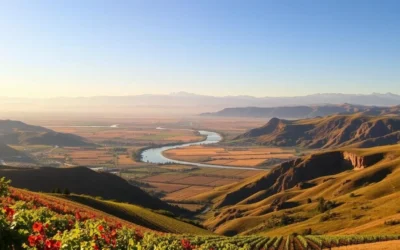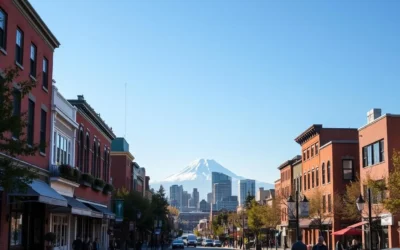✓ Accommodations ✓ Flights ✓ Rental Cars
As you explore the Evergreen State, you’ll find a fascinating linguistic landscape that reflects its rich cultural heritage and immigration history. With an estimated 7.79 million residents, Washington’s population is diverse, with 19.6% living in households where a language other than English is spoken.
Approximately 20.3% of persons over four years old, about 1.58 million people, speak a language other than English at home. Moreover, 7.84% of the state’s population has limited English proficiency. This data highlights the importance of understanding the language demographics in Washington.
You’ll gain insights into the language distribution across different counties and how it impacts various sectors such as education, healthcare, and public services.
The Multilingual Landscape of Washington State
As you explore Washington State, you’ll discover a vibrant tapestry of languages that reflect its diverse population. The state’s linguistic diversity is influenced by its history of immigration and cultural exchange.

English as the Predominant Language
While English is the predominant language in Washington State, it’s not the only language spoken. You might be surprised to learn that a significant proportion of residents speak a language other than English at home. According to the data, approximately 20.3% of Washington residents speak a language other than English at home, reflecting the state’s significant linguistic diversity.
Language Diversity Statistics
The data shows that language diversity isn’t evenly distributed across the state, with certain counties and regions showing much higher concentrations of non-English speakers. You’ll find that the percentage of multilingual households varies significantly by region, with urban areas typically showing greater linguistic diversity than rural communities. Census data reveals that Washington’s language landscape has evolved dramatically over recent decades, with increasing numbers of speakers of Asian and Pacific Island languages. In fact, the number of languages spoken in Washington schools exceeds 220, presenting both challenges and opportunities for the state’s education system. Notably, around 13.7% of the population is foreign-born, contributing to the state’s linguistic diversity.
Understanding these statistics helps you appreciate how Washington’s population demographics have shifted through various waves of immigration and internal migration. You’ll learn how Washington’s language diversity statistics compare to national averages and what this means for state policies and services, with certain statistics showing that around 20.3% of residents speak a language other than English, and some areas having a higher concentration of non-English speakers, with some counties having up to a certain percent of the population speaking a language other than English.
Washington’s Immigration History and Language Evolution
As you explore Washington’s linguistic diversity, you’ll discover that the state’s immigration history plays a significant role in shaping its language landscape. The influx of people from various parts of the world has contributed to the state’s multilingual identity.
Native American Languages and Heritage
Before European settlement, Native American languages were the primary languages spoken in the region. Washington is home to many Native American tribes, each with their own distinct language and cultural heritage. Although many of these languages are considered endangered, efforts are being made to preserve them.
European and Asian Immigration Waves
The late 20th century saw significant immigration waves from Europe and Asia, bringing new languages to the state. Spanish speakers became particularly prominent in agricultural regions, while Vietnamese, Filipino, and Russian speakers established communities throughout the state. 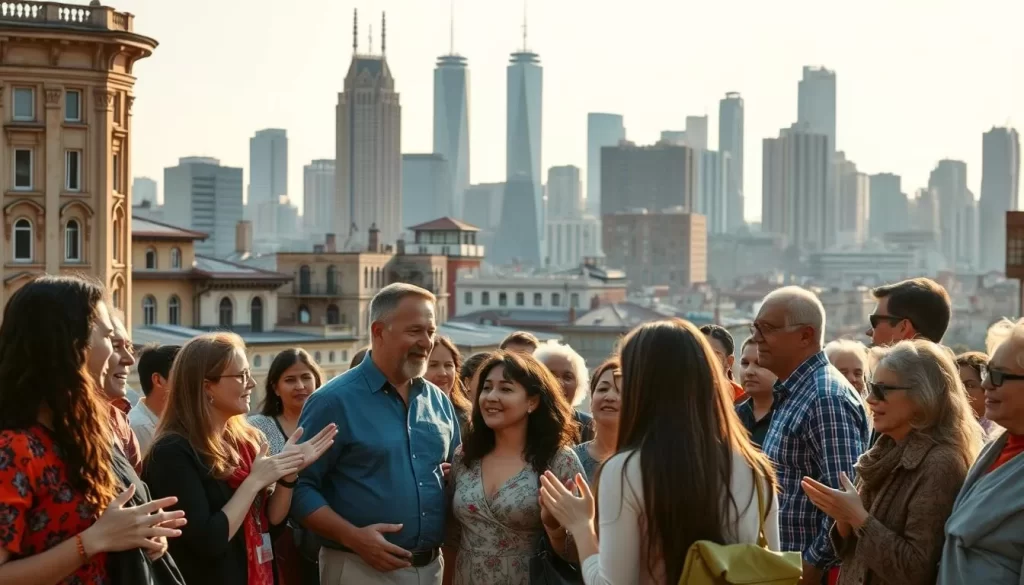
Modern Immigration Patterns
Today, Washington continues to attract immigrants from around the world. The tech industry has drawn highly skilled workers from India and China, while refugee resettlement programs have brought speakers of languages like Amharic and Tigrinya to the state. As a result, the state’s language landscape continues to evolve, with many schools now offering specialized English language learner programs to support students from diverse linguistic backgrounds.
Official and Widely Spoken Languages in Washington, United States
The state’s linguistic profile is characterized by a blend of native languages, immigrant languages, and English as the predominant language. As you explore the official and widely spoken languages in Washington, you’ll gain insight into the state’s language policies and their impact on residents.
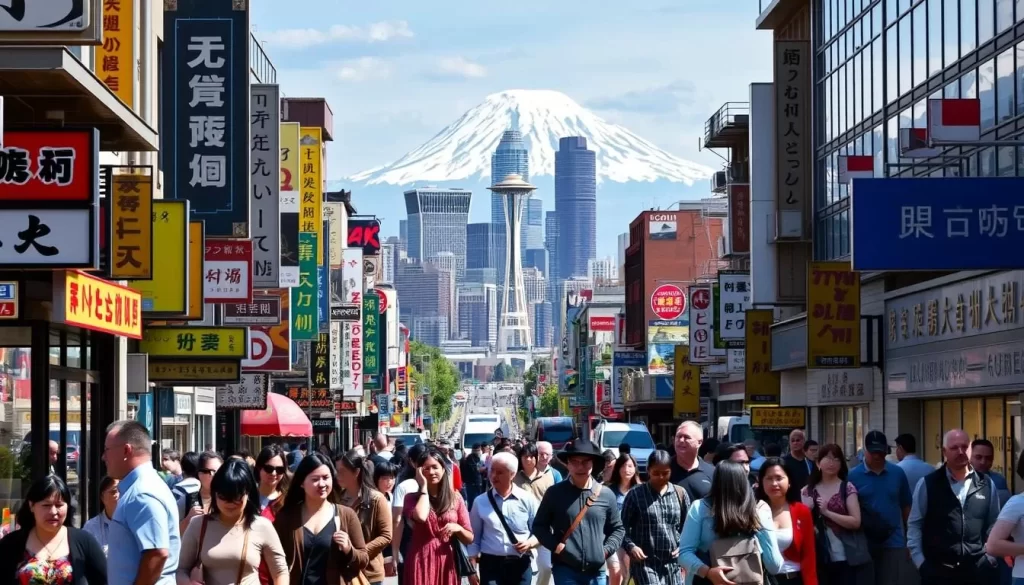
English: The De Facto Official Language
English is the most widely spoken language in Washington, serving as the de facto official language for government, education, and daily life. You might notice that while English dominates many aspects of state life, Washington has taken a more inclusive approach to language policy. The state focuses on providing access to services rather than declaring an official language. This approach is reflected in the language services provided for non-English speakers, particularly in essential areas like healthcare and education.
Language Policy in Washington State
Washington’s language policies emphasize practical accommodations for non-English speakers. For instance, the state established the Transitional Bilingual Instruction Program in 1979 to support students from non-English-speaking households. You should know that language access policies continue to evolve as Washington’s demographics change. The state’s court system also requires qualified interpreters for limited English proficient individuals, ensuring equal access to justice. Moreover, state agencies are increasingly providing translation services for vital documents and communications.
Top 10 Non-English Languages in Washington
As you explore the languages spoken in Washington, you’ll discover a vibrant mosaic of cultures and communities. The state’s linguistic diversity is reflected in the top 10 non-English languages spoken by its residents.
Spanish: The Most Common Non-English Language
Spanish is the most widely spoken non-English language in Washington, reflecting the state’s significant Hispanic and Latino population. You’ll find Spanish spoken across various communities, from urban centers like Seattle to rural areas.
Chinese Languages (Cantonese, Mandarin)
Chinese languages, including Cantonese and Mandarin, are also prevalent in Washington. Many residents of Chinese descent have made the state their home, contributing to the rich cultural tapestry.
Vietnamese
Vietnamese is another prominent language in Washington, with a sizable community, particularly in areas like SeaTac and Tacoma, where many Vietnamese refugees settled.
Tagalog and Filipino
Tagalog, the national language of the Philippines, is widely spoken among Filipino communities in Washington. You’ll find significant Filipino populations in cities like Seattle and Tacoma.
Russian
Russian is spoken by a considerable number of Washington residents, particularly in areas with historical ties to Russian immigration and cultural exchange.
Korean
Korean is also among the top non-English languages in Washington, reflecting the state’s connections with Korean culture and immigration.
Amharic, Somali, and Other Afro-Asiatic Languages
Amharic and Somali, among other Afro-Asiatic languages, are spoken by communities that have settled in Washington, often through refugee resettlement programs.
Hindi
Hindi, an official language of India, is spoken by a growing community in Washington, particularly in tech hubs and urban areas.
Austronesian Languages
Austronesian languages, including Tagalog and other languages from Southeast Asia and the Pacific, contribute to the linguistic diversity of Washington.
Ukrainian and Other Slavic Languages
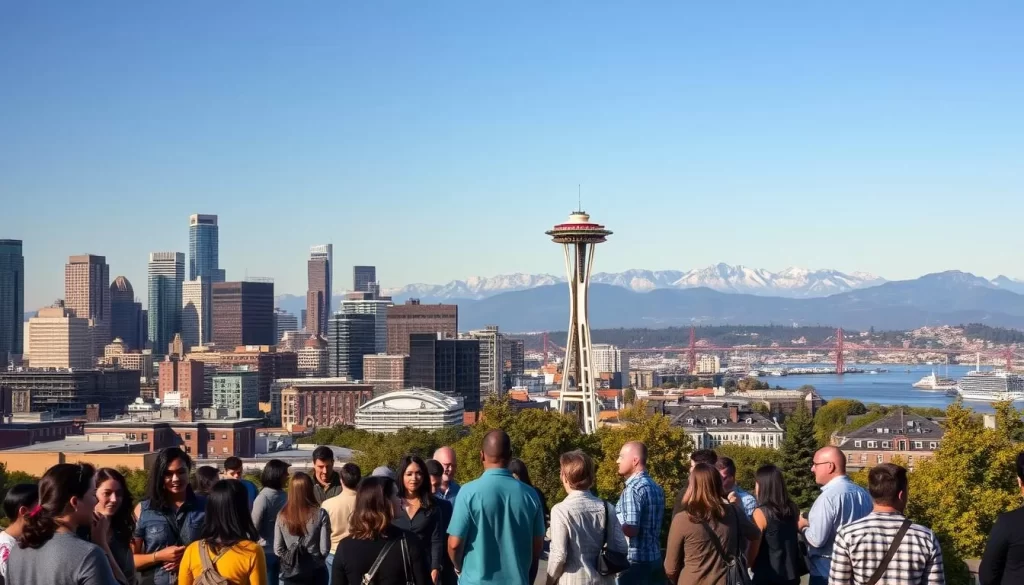 Ukrainian and other Slavic languages are spoken by approximately 31,819 residents, representing about 0.44% of the state’s population. These language communities are established in several regions, including Clark County, Spokane County, and the greater Seattle area. Many speakers arrived through refugee resettlement programs following the collapse of the Soviet Union. Religious communities, particularly Christian denominations, serve as cultural centers for these groups. Recent events in Ukraine have drawn attention to these established communities, highlighting the diverse cultural and national identities within them.
Ukrainian and other Slavic languages are spoken by approximately 31,819 residents, representing about 0.44% of the state’s population. These language communities are established in several regions, including Clark County, Spokane County, and the greater Seattle area. Many speakers arrived through refugee resettlement programs following the collapse of the Soviet Union. Religious communities, particularly Christian denominations, serve as cultural centers for these groups. Recent events in Ukraine have drawn attention to these established communities, highlighting the diverse cultural and national identities within them.
The percentage of speakers of Ukrainian and other Slavic languages has remained relatively stable, with established communities rather than new waves of immigration. Understanding the distinctions between Ukrainian, Russian, and other Slavic languages helps appreciate the diverse identities represented.
County-Level Language Distribution in Washington
As you explore the linguistic landscape of Washington, you’ll notice significant variations in language distribution across different counties. This diversity is shaped by factors such as immigration patterns, economic activities, and urban versus rural settings.
King County’s Multilingual Landscape
King County stands out for its multilingual landscape, with a high concentration of languages spoken due to its urban nature and the presence of major cities like Seattle. Data shows a significant percentage of residents speaking languages other than English at home, contributing to the county’s linguistic diversity.
Adams and Yakima Counties: Spanish-Speaking Regions
In contrast, counties like Adams and Yakima have a notable presence of Spanish-speaking populations. According to the data, Adams County has one of the highest percentages of persons who speak English less than “Very Well,” at 24.7%. This is largely due to agricultural activities that attract Spanish-speaking workers.
Rural vs. Urban Language Patterns
The contrast between rural and urban language patterns is striking. Rural counties tend to have either a predominantly English-speaking population or a significant Spanish-speaking community, especially in agricultural areas. Urban counties, on the other hand, display a more complex linguistic diversity with multiple languages represented. For instance, the percent of households speaking languages other than English varies dramatically across counties.
- You’ll find that counties like Pend Oreille and Wahkiakum have minimal linguistic diversity, with limited English proficiency rates as low as 0.2%.
- In contrast, urban areas and counties with significant agricultural sectors show more pronounced language diversity.
- The data highlights a strong correlation between economic activities, immigration patterns, and language distribution across Washington’s counties.
Limited English Proficiency Across the State
As you explore the linguistic landscape of Washington state, you’ll notice the significant presence of individuals with limited English proficiency. This phenomenon affects various aspects of life, from education to public services.
Statistics and Demographics
Washington’s education system serves approximately 130,000 English Language Learners (ELL) who speak a combined 220 languages. The majority of these students are in elementary school, with almost 53% in the third grade or younger. The Transitional Bilingual Instruction Program, established in 1979, provides critical support for students from non-English speaking households.
| Language Group | Number of Students | Percentage |
|---|---|---|
| Spanish | 84,500 | 65% |
| Other Languages | 45,500 | 35% |
Impact on Education and Public Services
Limited English proficiency significantly impacts how residents access healthcare and public services. Language barriers can affect diagnosis, treatment adherence, and patient satisfaction. The state’s court system has developed comprehensive language access plans to ensure limited English proficient individuals can fully participate in legal proceedings. Public agencies are increasingly providing translated materials and interpretation services, though implementation varies.
Language Diversity in Business and Healthcare
As you navigate the diverse linguistic landscape of Washington, you’ll find that language diversity significantly impacts both business and healthcare sectors. The need for effective translation and interpretation services has become paramount to ensure seamless communication across different languages.
Translation and Interpretation Services
Professional translation and interpretation services are crucial in facilitating accurate communication between healthcare providers and their patients. Companies like Acutrans specialize in providing interpretation services for various industries, including medical and technical fields, ensuring outstanding results every time.
Language Access in Healthcare Settings
Healthcare providers in Washington have developed sophisticated language access systems to cater to patients with limited English proficiency. Federal and state regulations mandate healthcare facilities to provide meaningful language access, driving improvements in medical interpretation services. This not only ensures compliance but also enhances patient care by providing patient-centered care.
| Industry | Service | Benefit |
|---|---|---|
| Healthcare | Interpretation Services | Improved Patient Care |
| Business | Translation Services | Enhanced Communication |
| Medical | Localization Services | Culturally Relevant Care |
Conclusion
Washington’s rich cultural tapestry is reflected in its language demographics, offering insights into the state’s past, present, and future. You’ve seen how English functions as the de facto official language while the state embraces linguistic diversity in homes, businesses, and communities. The data reveals regional variations in language use, from diverse urban centers to agricultural communities with significant Spanish-speaking populations. Understanding these demographics helps appreciate Washington’s global connections and local cultural diversity. As the state’s population continues to evolve, its linguistic diversity remains a defining characteristic and strength.
The above is subject to change.
Check back often to TRAVEL.COM for the latest travel tips and deals.
